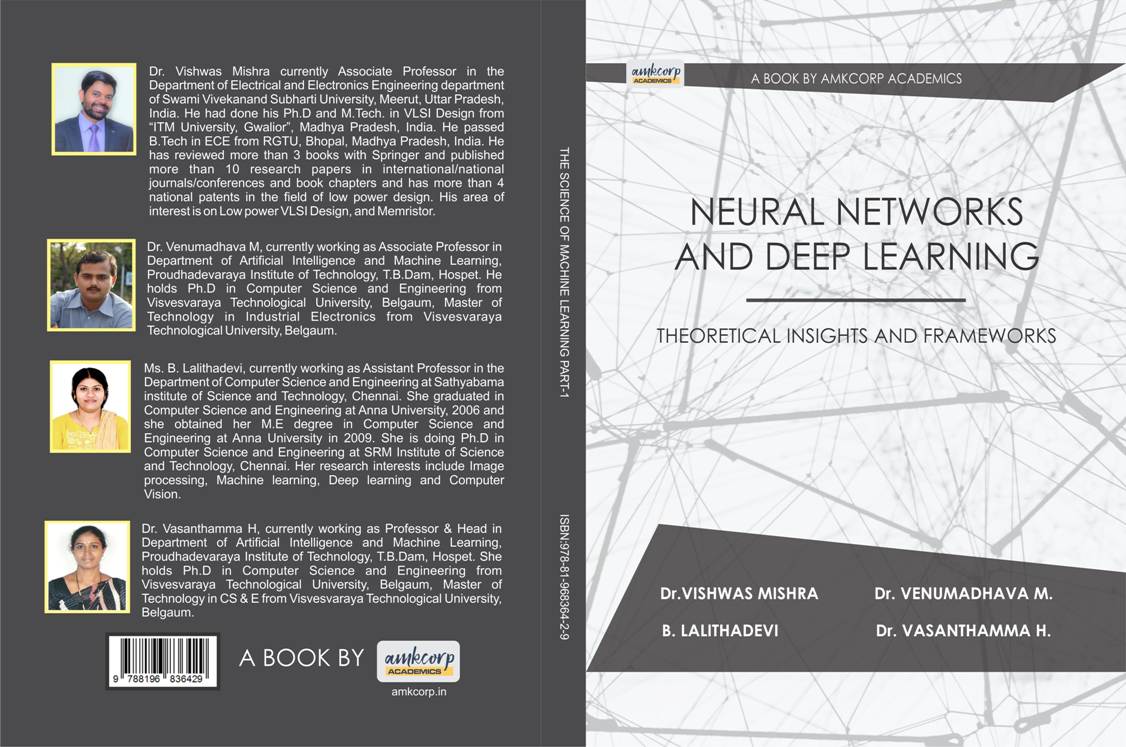



₹ 499.00
$ 40.00
ORDER PRINT
ORDER EBOOK

NEURAL NETWORKS AND DEEP LEARNING: THEORITICAL INSIGHTS AND FRAMEWORKS
AUTHOR(S) -
Dr. VISHWAS MISHRA, Dr. VENUMADHAVA M, B. LALITHADEVI, Dr. VASANTHAMMA H.
DOI – 10.61909/AMKEDTB022409
Genre/Subject – Computer Science
Book code – AMKEDTB022409 pgs: 200
ISBN(E) – 978-81-968364-9-8
Published – 27/02/2024
ISBN(P) – 978-81-968364-2-9
Published – 04/03/2024
AUTHOR(S)

Dr. VISHWAS MISHRA
Dr. Vishwas Mishra currently Associate Professor in the Department of Electrical and Electronics Engineering department of Swami Vivekanand Subharti University, Meerut, Uttar Pradesh, India. He had done his Ph.D and M.Tech. in VLSI Design from “ITM University, Gwalior”, Madhya Pradesh, India. He passed B.Tech in ECE from RGTU, Bhopal, Madhya Pradesh, India. He has reviewed more than 3 books with Springer and published more than 10 research papers in international/national journals/conferences and book chapters and has more than 4 national patents in the field of low power design. His area of interest is on Low power VLSI Design, and Memristor.

Dr. VENUMADHAVA M,
Dr. Venumadhava M, currently working as Associate Professor in Department of Artificial Intelligence and Machine Learning, Proudhadevaraya Institute of Technology, T.B.Dam, Hospet. He holds Ph.D in Computer Science and Engineering from Visvesvaraya Technological University, Belgaum, Master of Technology in Industrial Electronics from Visvesvaraya Technological University, Belgaum. He has vast teaching experience and also has published research papers in various reputed International Journals indexed with web of sciences, Scopus etc. His Research interests include Array Signal Processing, Wireless Sensor Networks, Information Centric Networks, Computer Vision, and Machine Learning.

B. LALITHADEVI
Ms. B. Lalithadevi, currently working as Assistant Professor in the Department of Computer Science and Engineering at Sathyabama institute of Science and Technology, Chennai. She graduated in Computer Science and Engineering at Anna University, 2006 and she obtained her M.E degree in Computer Science and Engineering at Anna University in 2009. She is doing Ph.D in Computer Science and Engineering at SRM Institute of Science and Technology, Chennai. Her research interests include Image processing, Machine learning, Deep learning and Computer Vision. Meanwhile, she has published a research articles in SCI-indexed journals and reputed International Journals. A variety of papers have been presented and published in International Conference and National Conference. She has participated in various workshops and faculty development programs for improving her technical growth. She is a member of the IAENG association

Dr. VASANTHAMMA H.
Dr. Vasanthamma H, currently working as Professor & Head in Department of Artificial Intelligence and Machine Learning, Proudhadevaraya Institute of Technology, T.B.Dam, Hospet. She holds Ph.D in Computer Science and Engineering from Visvesvaraya Technological University, Belgaum, Master of Technology in CS & E from Visvesvaraya Technological University, Belgaum. She has vast teaching experience and also has published research papers in various reputed International Journals indexed with web of sciences, Scopus etc. Her Research interests include Wireless Sensor Networks, Information Centric Networks, Computer Vision, and Machine Learning.
ABOUT BOOK / ABSTRACT
“NEURAL NETWORKS AND DEEP LEARNING: THEORITICAL INSIGHTS AND FRAMEWORKS” is a comprehensive guide that dives deep into the world of neural networks and their applications in modern technology. From foundational theories to cutting-edge advancements, this book provides readers with a comprehensive understanding of deep learning and its potential impact on various fields.
In Chapter 1: Introduction to Neural Networks and Deep Learning, readers are introduced to the theoretical underpinnings of deep learning and its real-world applications. The chapter explores key concepts, navigates through neural network architectures, and discusses the current landscape of deep learning research. It also addresses ethical considerations and social implications, highlighting the intersection of deep learning with other disciplines.
Chapter 2: Mathematical Foundations of Neural Networks lays the groundwork by covering essential mathematical concepts relevant to deep learning. From linear algebra to calculus, probability, and statistics, readers gain insights into the mathematical rigor behind neural network operations. The chapter also delves into optimization techniques and advanced mathematical concepts crucial for understanding deep learning models.
Chapter 3: Single-Layer Perceptrons and Feedforward Networks explores the building blocks of neural networks, including perceptrons and activation functions. It discusses universal approximation theorems, backpropagation algorithms, and weight initialization techniques. Additionally, the chapter addresses challenges such as vanishing and exploding gradient problems, along with evolutionary algorithms and self-organizing maps.
Chapter 4: Convolutional Neural Networks (CNNs) focuses on specialized architectures designed for image processing tasks. Readers learn about convolutional layers, pooling operations, and hierarchical feature learning. The chapter also covers object localization, transfer learning, and interpretability of CNNs, along with advanced architectures like capsule networks.
Chapter 5: Recurrent Neural Networks (RNNs) delves into sequential data processing, temporal dependencies, and architectures like Long Short-Term Memory (LSTM) networks and Gated Recurrent Unit (GRU) networks. It addresses training challenges and explores real-world applications of recurrent networks.
Chapter 6: Generative Adversarial Networks (GANs) introduces readers to the innovative concept of GANs and their applications in image generation. The chapter discusses training dynamics, challenges, and ethical considerations surrounding GANs. It also explores future developments and applications in creativity and adversarial robustness.
Chapter 7: Autoencoders and Variational Autoencoders (VAEs) explores unsupervised learning techniques for representation learning and anomaly detection. Readers learn about various types of autoencoders, including adversarial autoencoders and quantum autoencoders.
Chapter 8: Reinforcement Learning and Deep Q Networks (DQNs) provides insights into reinforcement learning fundamentals, Markov decision processes, and deep Q networks. It discusses policy gradient methods and their applications in real-world scenarios.
Chapter 9: Transfer Learning in Deep Neural Networks explores transfer learning paradigms, domain adaptation techniques, and the role of transfer learning in achieving explainable AI. Readers gain insights into evaluating performance and generalization in transfer learning, along with applications in various domains.
“NEURAL NETWORKS AND DEEP LEARNING: THEORITICAL INSIGHTS AND FRAMEWORKS” is an invaluable resource for researchers, practitioners, and enthusiasts looking to deepen their understanding of neural networks and harness the power of deep learning in diverse applications.




